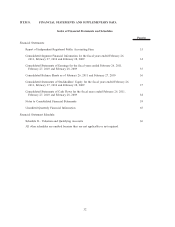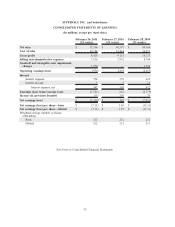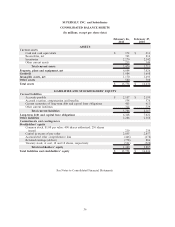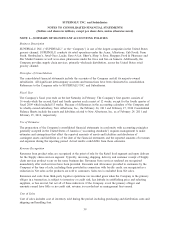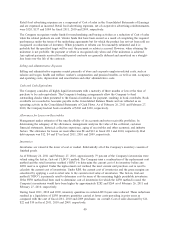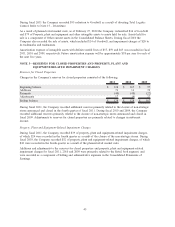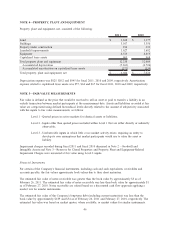Albertsons 2011 Annual Report Download - page 43
Download and view the complete annual report
Please find page 43 of the 2011 Albertsons annual report below. You can navigate through the pages in the report by either clicking on the pages listed below, or by using the keyword search tool below to find specific information within the annual report.SUPERVALU INC. and Subsidiaries
NOTES TO CONSOLIDATED FINANCIAL STATEMENTS
(Dollars and shares in millions, except per share data, unless otherwise noted)
NOTE 1—SUMMARY OF SIGNIFICANT ACCOUNTING POLICIES
Business Description
SUPERVALU INC. (“SUPERVALU” or the “Company”) is one of the largest companies in the United States
grocery channel. SUPERVALU conducts its retail operations under the Acme, Albertsons, Cub Foods, Farm
Fresh, Hornbacher’s, Jewel-Osco, Lucky, Save-A-Lot, Shaw’s, Shop ’n Save, Shoppers Food & Pharmacy and
Star Market banners as well as in-store pharmacies under the Osco and Sav-on banners. Additionally, the
Company provides supply chain services, primarily wholesale distribution, across the United States retail
grocery channel.
Principles of Consolidation
The consolidated financial statements include the accounts of the Company and all its majority-owned
subsidiaries. All significant intercompany accounts and transactions have been eliminated in consolidation.
References to the Company refer to SUPERVALU INC. and Subsidiaries.
Fiscal Year
The Company’s fiscal year ends on the last Saturday in February. The Company’s first quarter consists of
16 weeks while the second, third and fourth quarters each consist of 12 weeks, except for the fourth quarter of
fiscal 2009 which included 13 weeks. Because of differences in the accounting calendars of the Company and
its wholly-owned subsidiary, New Albertsons, Inc., the February 26, 2011 and February 27, 2010 Consolidated
Balance Sheets include the assets and liabilities related to New Albertsons, Inc. as of February 24, 2011 and
February 25, 2010, respectively.
Use of Estimates
The preparation of the Company’s consolidated financial statements in conformity with accounting principles
generally accepted in the United States of America (“accounting standards”) requires management to make
estimates and assumptions that affect the reported amounts of assets and liabilities and disclosure of
contingent assets and liabilities as of the date of the financial statements and the reported amounts of revenues
and expenses during the reporting period. Actual results could differ from those estimates.
Revenue Recognition
Revenues from product sales are recognized at the point of sale for the Retail food segment and upon delivery
for the Supply chain services segment. Typically, invoicing, shipping, delivery and customer receipt of Supply
chain services product occur on the same business day. Revenues from services rendered are recognized
immediately after such services have been provided. Discounts and allowances provided to customers by the
Company at the time of sale, including those provided in connection with loyalty cards, are recognized as a
reduction in Net sales as the products are sold to customers. Sales tax is excluded from Net sales.
Revenues and costs from third-party logistics operations are recorded gross when the Company is the primary
obligor in a transaction, is subject to inventory or credit risk, has latitude in establishing price and selecting
suppliers, or has several, but not all of these indicators. If the Company is not the primary obligor and
amounts earned have little or no credit risk, revenue is recorded net as management fees earned.
Cost of Sales
Cost of sales includes cost of inventory sold during the period, including purchasing and distribution costs and
shipping and handling fees.
39





